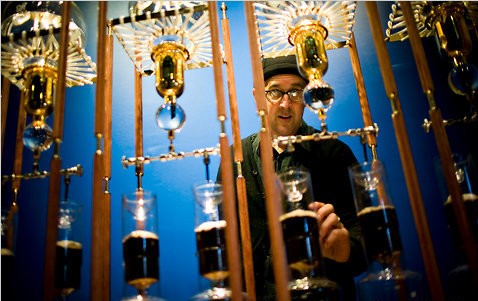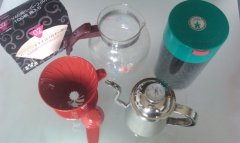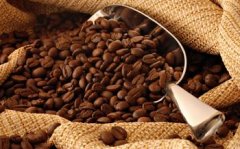Coffee training knowledge the making of water drop coffee and ice drop coffee

Photo Source: New York Times
I once read a report: Mr. Timko, the boss of an American boutique coffee company, felt very distinctive after seeing ice drop coffee in Japan, and fell in love with it after tasting it, so he studied and promoted it.
Ice drop coffee, also known as water drop coffee, ice brewed coffee, is a way to make coffee drinks. Ice drop coffee uses ice water, cold water or ice cubes to extract coffee, which is very slow and often takes hours, so ice drop coffee is more expensive.
History: the apparatus for making iced coffee was invented in the Netherlands, also known as the Dutch iced coffee drip filter. After being carried forward by the Japanese, the current production of ice drop coffee maker is mostly Japanese manufacturers. Ice drop coffee has also become popular in the United States in recent years.
Production: the upper layer of the Dutch iced coffee drip filter is a container of water, ranging from 500cc to 3000cc according to capacity. At the bottom of the container is a switch that controls the flow of water, a long tube containing coffee powder in the middle, and a glass pot that holds coffee. When in use, put cold boiled water or ice into the upper container and coffee powder into the middle tube. The coffee powder is about between the thickness of the powder used in the French filter press and the siphon coffee maker. Turn on the switch of the upper container and let the water drop one drop at a time. The water will slowly seep through the coffee powder and drop into the lower glass pot. Basically, it's about an hour of 100cc. Adjust it to 3-5 seconds a drop as needed.
Drink: drink well in the refrigerator after drinking, the taste will be more rich and delicious.
Principle: ice drop coffee is mainly extracted by condensation natural osmotic water pressure and bit by bit. The taste of the extracted coffee will change according to the coffee roasting degree, water quantity, water temperature, water drop speed, coffee grinding thickness and other factors, and the extracted coffee has different flavor.
Features: coffee powder is 100% soaked in low temperature and moist, and the extracted coffee has a strong, smooth and rich taste. Adjust the speed of water droplets, slowly dripping with cold water, with a low temperature of 5 degrees Celsius, dripping for a long time, rich coffee flavor and low caffeine content.
Important Notice :
前街咖啡 FrontStreet Coffee has moved to new addredd:
FrontStreet Coffee Address: 315,Donghua East Road,GuangZhou
Tel:020 38364473
- Prev

Hand-brewed coffee one of the best ways to taste individual coffee
Hand-made coffee and siphon coffee should be the two most popular coffee practices in Japan. Relatively speaking, hand style is the easiest way to get started, and it is also one of the best ways to taste individual coffee. First, let's talk about the preparation of the tools: 1. A Tiamo kettle with a thermometer 2, a Hario V60 filter cup 3, tapered filter paper 4, and a pot for coffee is installed in a very simple way.
- Next

Tasting coffee is a highly professional discipline.
Coffee tasting is a very professional knowledge, there are many terms, too numerous to list. Here we list some of the simplest and most commonly used ones. If you have a chance to read professional books on coffee in the future, I am sure you will use them.
Related
- Beginners will see the "Coffee pull flower" guide!
- What is the difference between ice blog purified milk and ordinary milk coffee?
- Why is the Philippines the largest producer of crops in Liberia?
- For coffee extraction, should the fine powder be retained?
- How does extracted espresso fill pressed powder? How much strength does it take to press the powder?
- How to make jasmine cold extract coffee? Is the jasmine + latte good?
- Will this little toy really make the coffee taste better? How does Lily Drip affect coffee extraction?
- Will the action of slapping the filter cup also affect coffee extraction?
- What's the difference between powder-to-water ratio and powder-to-liquid ratio?
- What is the Ethiopian local species? What does it have to do with Heirloom native species?

